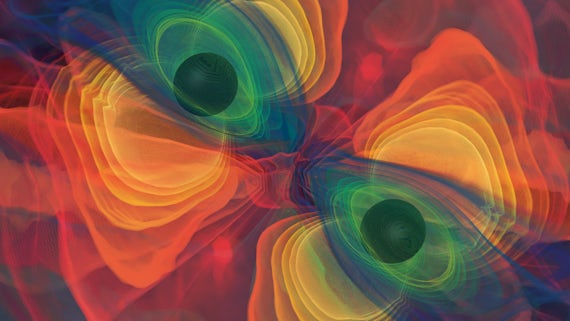Neutron star binary searches
Mae'r cynnwys hwn ar gael yn Saesneg yn unig.

Our research looks at neutron star binaries which are one of the best candidate sources for gravitational wave emission.
Neutron star binaries are the most secure source of gravitational wave signals for the advanced detector network.
Our current work focuses on preparing a neutron star binary search for the advanced detector era. This will be an extension of the search pipeline that we have developed over the past decade.
Gravitational wave detection
While the first direct detection of gravitational waves was truly a landmark event, it is the observation of numerous sources that will transform our understanding of compact binaries.
Gravitational wave observations will provide us with direct measurements of the masses and spins of compact objects, which are complementary to the electromagnetic luminosities, durations and redshifts obtained from telescopes and satellites. Combining this information on an event-by-event or population basis will shed new light on binary formation and evolution.
Observation of these sources may well yield further direct detection of gravitational waves.
Additionally, gravitational wave observations will:
- provide measurements of the mass and possibly spin distribution of neutron stars, providing insight into formation mechanisms and probing the predicted 'mass gap' of compact objects between around three and five solar masses
- place constraints on the neutron star equation-of-state and consequently the properties of matter at extreme densities
- measure the Hubble constant from gravitational wave observations alone.
Furthermore, joint gravitational wave and electromagnetic observations will allow us to investigate the astrophysical environments of these systems, while independent measurements of distance (from gravitational waves) and redshift (electromagnetic) will test cosmological models.
The gravitational waveform emitted during the inspiral of two neutron stars or a neutron star and a black hole can be modelled analytically using post-Newtonian (PN) theory – a perturbative solution to Einstein’s equations, which has now been calculated to seventh order in the velocity of the component stars.
These analytical waveforms provide accurate templates that are used to perform a match filter search of the data for signals.
The overriding challenge is to perform a sensitive search of large stretches of non-Gaussian data for weak gravitational waves signals and accurately extract the parameters of the signals.
LIGO scientists detect gravitational wave signal from the merging of two black holes.


